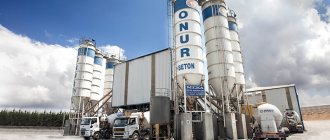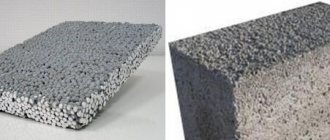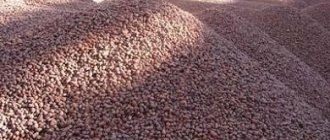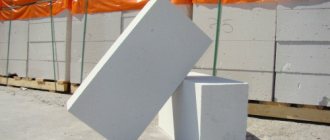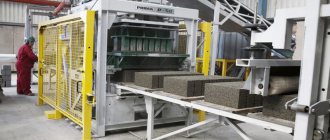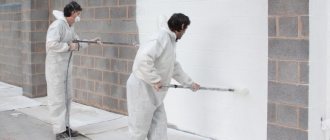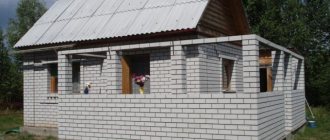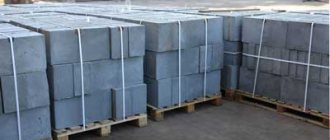At different times and to this day, the technology of building walls has remained virtually unchanged. Stones, bricks, wood, clay, concrete - all this formed the basis of the house and always reliably protected the interior from bad weather and heat. But technology never stands still, and thus, by the twenty-first century, an improved concrete prototype was developed - the foam block.
Developers actively use this material for low-rise buildings, because foam concrete is an almost unique building element. Moreover, the production of foam blocks is now widely available at home. Therefore, many people actively use this, and thereby earn their living and more.
Complete absence of moisture condensation, fire safety, sound insulation, excellent heat retention compared to even denser materials, ease of installation (they are easy to create, cut, drill, and, moreover, are lightweight), complete savings on production and transportation. And these are just a few of the characteristic advantages of foam concrete. As you can see for yourself, this porous concrete material is a small miracle of the modern construction industry. And from this very miracle, many people make money, because this requires only initiative and not too much starting capital.
In this article we will tell you about what is needed to produce foam blocks, tell you about the profitability of this type of business in monetary terms, and also describe the numerous subtleties of the technology for producing foam blocks at home.
Characteristics and applicability of foam blocks
Foam concrete is one of the varieties of cellular concrete, in which a porous structure is created by adding a foaming agent to the solution. This composition initiates the formation of air bubbles with a diameter of about 1–2 mm, causing a reduction in the weight of the material without compromising strength. Foam concrete is used to make building blocks with dimensions up to 30x40x60 cm, which is equivalent to the volume of 36 bricks.
The production of foam blocks as a business is focused primarily on the construction or reconstruction of low-rise residential buildings, agricultural and industrial facilities, country and garage buildings, warehouse and commercial buildings. In these works, foam blocks are used for:
- construction of external and load-bearing walls;
- insulation and soundproofing of partitions and ceilings;
- arrangement of light interior walls;
- construction of chambers with special temperature conditions;
- increasing the number of floors without altering the foundation.
The characteristics of foam concrete prove that this material is extremely promising for solving construction problems. In particular:
- In the first few years, the products continue to gain strength. The strongest brands can easily withstand the weight of a four-story building.
- Thanks to air bubbles, the material perfectly absorbs sound vibrations. A 300 mm thick wall attenuates them by 40–60 dB.
- The blocks do not burn at all, do not deform under the influence of high temperatures and do not emit compounds hazardous to health when heated.
- Foam concrete, thanks to its closed pores, tolerates frost well. A wall can last 50–75 years without loss of quality.
- Despite their high strength, the products can be easily processed with a regular hacksaw. This allows the architect’s non-standard ideas to be implemented.
To be fair, we should also mention the disadvantages that are characteristic of this material:
- When the standard strength is gained within two months, the products shrink by 0.2–0.4%. This must be taken into account when constructing walls and partitions.
- The blocks are quite fragile. When impacted, they crack and crumble, and under serious bending load, they simply burst.
- The appearance of the material can hardly be called attractive. The blocks have a rough surface and a dirty gray color, so they need additional finishing.
Download Detailed Business Plan
Project Summary
The products are aimed at construction contractors, construction bases and federal chains of hypermarkets for construction materials.
The peculiarity of the sphere is that the sales market will not be limited only to its own city. Having established transport logistics, it is possible to enter the market of nearby settlements and even neighboring regions, provided that there are no manufacturers of these products there or it is possible to offer better or cheaper blocks. Foam concrete is the material from which blocks are made. It consists of a mixture of cement and air foam. Due to the airiness of the foam, the block is saturated with air, becoming porous and light.
The production of foam blocks includes several stages:
- Preparation of foam concrete.
- Molding.
- Drying.
- Storage of finished products.
The difference between foam blocks and gas blocks
Most often, a foam block is compared with its closest analogue from the category of cellular concrete - a gas block. The key difference is the method of generating bubbles: in aerated concrete they are formed due to the release of hydrogen from the reaction between calcium hydroxide added to the solution and a suspension of aluminum powder. As a result, aerated concrete takes on the light, almost white color of sand-lime brick, while foam concrete remains gray.
In addition, fans of different materials often argue about what is best to use in construction - brick, foam concrete or wood. The characteristics of foam blocks show that they are clearly not on the list of outsiders:
- The material usually has a density of 600–800 kg/m³, which is comparable to wood. Aerated concrete has the same density, and brick is three times heavier.
- Foam concrete retains heat 3.5–4 times better than sand-lime brick and only 20% worse than wood. Walls made from it save heating costs by 25–35%.
- Water absorption by a foam block does not exceed 8–12% of its weight. For ordinary bricks this figure reaches 14–16%, and for foam concrete - 25%.
- Foam concrete, like ceramic brick, can easily withstand temperatures up to 500°C, which is critical for wood.
- The material is considered no less environmentally friendly than wood. Its natural radiation background is five times less than that of a brick.
- Foam blocks are available for customers on a limited budget. A cubic meter of foam concrete sells for 3,000 rubles, bricks for 6,000 rubles, and boards for 4,500 rubles.
Types of markings
In construction, foam blocks of different densities are used, depending on the purpose. This characteristic is denoted by the Latin letter D with a numerical index indicating the weight of a cubic meter of material in kilograms. There are:
- D100 - D Used for the construction of internal partitions of residential and public buildings.
- D400 - D Suitable for insulation and soundproofing of walls, floors and interfloor ceilings.
- D600 - D They are used both for thermal insulation of structures and for the construction of external walls.
- D1000 - D Designed for installation of load-bearing walls, columns, lintels and other structural elements.
According to industry standards, after testing in the laboratory, units may receive additional markings indicating their characteristics:
- The symbol B with numbers indicates the compressive strength of the product. Index values from 0.5 to 60 indicate the load in kgf/cm² that the block can withstand.
- The F symbol with numbers from 15 to 75 indicates frost resistance. The index after it indicates the permissible number of freezing and defrosting cycles.
Buyers pay attention to the technology of drying finished products. Experience shows that it partly affects the strength of the material. There are blocks:
- Autoclaved. After setting, the solution is kept for several hours in a sealed chamber at a temperature of 170–210°C and a pressure of 0.8–1.2 MPa;
- Non-autoclaved. They are dried and ripened for 28 days under natural conditions, at room temperature and humidity.
Foam blocks also differ in size, which allows builders to select them in accordance with the task at hand:
Dimensions of concrete foam blocks
| Dimensions | Quantity per cubic meter |
| 100 × 300 × 600 mm | 55 pcs. |
| 120 × 300 × 600 mm | 46 pcs. |
| 150 × 300 × 600 mm | 37 pcs. |
| 200 × 300 × 600 mm | 27 pcs. |
| 250 × 300 × 600 mm | 22 pcs. |
| 400 × 300 × 600 mm | 20 pcs. |
Finally, foam blocks can be classified according to their purpose during construction work. The assortment looks like this:
- Standard. They have a thickness of 200–300 mm, which allows them to be used to solve any problems.
- For partitions. They differ in thickness of 100–150 mm, and therefore are well suited for arranging interior walls.
- U-shaped. They have the form of a tray into which a reinforcing belt, dressings or utility lines are placed.
- Reinforced. They are blocks and beams reinforced with a steel frame, suitable as lintels.
- Non-standard. They differ in protrusions, cutouts, internal voids or complex shapes. They are mainly produced to order.
What are foam blocks made of?
Essentially, a foam block consists of cement mortar, fine sand, water and air. There is no need to choose air, but other components need to be paid special attention so that the finished product does not disappoint consumers. What is needed to make foam blocks:
- Portland cement grade M400 and higher (preferably M500). The material must be chosen fresh, and not compacted in a warehouse for several months.
- Quartz river sand, fraction 0.8–1.2 mm, containing no more than 3% silty impurities and clay. It must be dry, otherwise the proportions of the solution will be disrupted.
- Polypropylene or basalt fiber. Respectable manufacturers add it to the solution to prevent cracking of the blocks.
- Tap water at a temperature of 10–25°C. You can use artesian if it does not contain acidic or alkaline precipitation.
- Foaming agent. It can be natural (based on tree resin, bone glue, rosin) or synthetic (caustic soda, polymer compounds).
- Additives that improve the quality of the product. These include hardening accelerators, plasticizers, silica, and dyes.
- Lubricant to prevent cement from sticking to forms. It should decompose on its own within a few days so that no oil stains remain on the blocks.
- Package. Finished blocks on a pallet must be wrapped in plastic film. If they dry out too much, they may crack.
The proportions in which raw materials are mixed for the manufacture of foam blocks in accordance with the requirements of GOST 21520-89 and GOST 25485-89 are determined by the required density of the finished products:
Composition of foam blocks
| Compound | D400 | D600 | D800 | D1000 | D1200 | D1400 | D1600 |
| Sand, kg | – | 210 | 420 | 590 | 780 | 950 | 1130 |
| Cement, kg | 300 | 310 | 320 | 350 | 360 | 380 | 400 |
| Water for solution, l | 110 | 110 | 120 | 120 | 140 | 150 | 160 |
| Water for foam, l | 60 | 55 | 45 | 40 | 35 | 28 | 20 |
| Foaming agent, kg | 1,5 | 1,3 | 1,2 | 1,0 | 0,9 | 0,7 | 0,6 |
| Finished foam, l | 800 | 715 | 630 | 560 | 460 | 370 | 290 |
| Fiber, kg | 0,5 | 0,5 | 0,5 | 0,5 | 0,6 | 0,6 | 0,6 |
| Ready mixture, kg | 470 | 685 | 910 | 1105 | 1515 | 1510 | 1715 |
| Air content, % | 80 | 70 | 65 | 55 | 45 | 35 | 30 |
Foam concrete production technology
The technology for producing foam blocks is based on mechanical mixing of the ingredients for 5–10 minutes, followed by pouring the foam solution into stainless steel molds.
What does the production cycle look like:
- Bulk components are preliminarily cleaned of debris and lumps using a vibrating sieve with a mesh size of 1.5–2 mm.
- Sand in a bunker is mixed with cement in specified proportions. The required weight is measured using a special dispenser.
- If the technology includes the use of fiber, it is immediately added to the water and mixed thoroughly. Then water is gradually poured into the cement-sand mixture.
- The second portion of water is mixed with a foaming agent until a homogeneous mass is obtained. It is important to maintain the correct temperature, otherwise the chemical will not dissolve.
- Spray molds are coated with lubricant. Oily compounds cannot be used: they leave stains on the blocks to which the plaster does not stick.
- The solution is prepared for pouring into molds. At this stage, use one of the available methods for obtaining an aqueous mixture of ingredients:
- In a pressure unit . This is affordable equipment for the production of foam blocks at home, which connects all components under pressure at once. But it is difficult to maintain the recipe in the chamber, which has a bad effect on quality.
- With foam generator . All dry ingredients are mixed in advance, and only then water and foam solution are added. This allows you to accurately control the amount of raw materials and obtain stable quality.
- The mixed solution is poured into the formwork. Here one of two options for forming products is also used:
- Casting. The mold container is initially divided by steel partitions into sections according to the size of the blocks. Accordingly, for products of different dimensions it is necessary to use different formworks.
- By cutting. The form has a large volume, about 0.7–0.8 m³. When the cement block hardens, it is cut with band saws into blocks of given dimensions. The dimensions are observed very precisely, but installation costs half a million rubles.
- The foam concrete is covered with polyethylene and left in the mold for 10–12 hours. In hot weather, to prevent rapid drying out, the blocks are watered every couple of hours.
- When the solution hardens and gains sufficient strength to be removed from the molds, the blocks are dried in one of two ways:
- under natural conditions in a warehouse, for four weeks;
- in an autoclave for 4–6 hours at elevated temperature and pressure.
- Finished products are placed on pallets, wrapped in film and transported to the warehouse. This completes the foam block production cycle.
Business registration
Even a small home production of foam blocks should be registered if the entrepreneur plans to sell the products to neighbors and friends. In most cases, an individual entrepreneur is sufficient, but for fulfilling government and corporate orders, an LLC seems preferable. When submitting an application, you must select the following codes:
OKVED for foam block production
| 23.61 | Production of concrete products for use in construction |
| 23.61.1 | Production of finished building products from cement and concrete |
Of all the preferential taxation systems, only the simplified taxation system is available to an entrepreneur. Its variety will help you choose a business plan for the production of foam blocks: if the expected profitability exceeds 67%, you should switch to a rate of 6%, otherwise it is more reasonable to indicate a rate of 15% in the application for registration of individual entrepreneurs.
Before starting activities, it is necessary to undergo inspections and obtain permits from Rospotrebnadzor and the Fire Service. To sell finished products, it is useful to obtain a quality certificate: formally, its presence is not mandatory, but buyers are attracted by proof that the foam blocks comply with GOST requirements.
Certification is carried out by specialized laboratories and centers that are accredited by Rostest. The cost of the service depends on what needs to be done:
- If an entrepreneur wants to certify a complete production, he must submit a detailed design of the production line, information about the quality control system and a process organization diagram.
- Only batches of products can be certified. To do this, you need documents for all raw materials used. Trusted suppliers of sand, concrete and chemicals are always ready to send such evidence of quality to the client.
- In both the first and second cases, the laboratory tests the product for compliance with the standards of strength, safety, heat transfer and water absorption. If necessary, check the density and frost resistance of products.
What documents are needed for registration?
If the company will work with individuals, then an individual entrepreneur will open. The activities of a legal entity require registration of an LLC.
At the tax office you need to go through the standard procedure for registering a business. To do this you will need the following documents:
- statement;
- completed taxpayer application form;
- photocopy of passport;
- receipt of payment of state duty;
- certificate of opening a bank account (if an LLC is being formed).
It is also necessary to obtain permits from the fire inspectorate and Rospotrebnadzor.
Workshop requirements
When planning the production of foam blocks at home, entrepreneurs usually use any available premises - garages, sheds, summer cottages. But in order to create a full-fledged workshop and produce at least 30 m³ of products per day, you will need an area of at least 300 m². Here will be located:
- area for storing ingredients - 80 m²;
- working area with a foam block production line - 120 m²;
- room for drying and storing products - 80 m²;
- administrative offices - 20 m².
When setting up an enterprise in an old production or warehouse workshop of a former factory, you will have to carry out some preparatory operations. In particular:
- An uninterrupted water supply is required for operation. At temperatures below 10°C it will have to be heated in flow-through boilers.
- Sufficient power supply must be ensured. Machines for the production of foam blocks consume a total of about 30–40 kW.
- The premises must have heating. Products gain strength much more efficiently at air temperatures above 15°C.
- The workshop should be equipped with a ventilation system. With high humidity, cement sticks together, sand becomes damp, and finished blocks take too long to dry.
- Access roads may need to be constructed. In order to bring tens of tons of raw materials every day and ship heavy products, good roads are needed.
Equipment for the production of foam blocks
Considering different technologies for the production of foam blocks, it should be noted that a pressure unit is unlikely to be suitable for a full-fledged enterprise: it is difficult to regulate the density and strength of the finished products, and variations in quality may raise doubts among consumers. At the same time, buying an autoclave chamber for half a million rubles to produce only 25–40 m³ blocks is also irrational. Of course, products without it will be slightly less durable, but this drawback can be corrected by reducing the price. Taking into account the above, the workshop equipment specification will take the following form:
Equipment for the production of foam blocks
| Position | price, rub. | Quantity, pcs. | Amount, rub. |
| Manufacturing facility | |||
| Vibrating sieve | 22000 | 1 | 22000 |
| Scraper conveyor | 71000 | 2 | 142000 |
| Bunker for raw materials | 138000 | 2 | 276000 |
| Foam generator | 210000 | 1 | 210000 |
| Mixer 5 m³/h | 195200 | 1 | 195200 |
| Compressor | 38900 | 1 | 38900 |
| Container for water | 10000 | 1 | 10000 |
| Water dispenser | 30000 | 1 | 30000 |
| Foam dispenser | 30000 | 1 | 30000 |
| Sand and cement dispenser | 185000 | 1 | 185000 |
| Form for foam blocks | 24900 | 30 | 747000 |
| Cargo cross beam | 19000 | 1 | 19000 |
| Switchboard | 6000 | 1 | 6000 |
| Solution pump | 110200 | 1 | 110200 |
| Instantaneous water heater | 41900 | 1 | 41900 |
| KAMAZ truck | 470000 | 1 | 470000 |
| Forklift | 360000 | 1 | 360000 |
| Rokla | 16500 | 2 | 33000 |
| Pallet | 250 | 60 | 15000 |
| Office equipment | |||
| Table | 2500 | 2 | 5000 |
| Armchair | 1500 | 2 | 3000 |
| Computer | 26000 | 2 | 52000 |
| Telephone set | 1800 | 1 | 1800 |
| Filing Cabinets | 4500 | 1 | 4500 |
| MFP | 10000 | 1 | 10000 |
| Total: | 2837700 | ||
Enterprise team
With production volumes not exceeding two to three cubic meters per day, it is quite possible to start producing foam blocks with your own hands. But if the workshop capacity increases to 25–30 m³, the entrepreneur will not be able to simultaneously engage in work and solve administrative tasks. Accordingly, he will need:
- a technologist who will monitor compliance with the recipe and control the quality of finished products;
- operators of the foam block production line who will prepare the solution, pour it into molds and remove the dried blocks;
- auxiliary workers for delivering raw materials from the warehouse, carrying finished blocks and performing other loading and unloading operations;
- a storekeeper who controls the movement of raw materials and finished products, and a driver who will operate the forklift and truck.
For small volumes of reporting, the business owner himself can handle the accounting, although if necessary, you can hire a part-time specialist for this position. Thus, the mini factory for the production of foam blocks will operate:
Enterprise employees
| Job title | Rate, rub. | Qty | Amount, rub. |
| Technologist | 25000 | 1 | 25000 |
| Solution preparation operator | 20000 | 2 | 40000 |
| Forming operator | 20000 | 1 | 20000 |
| Helper worker | 16000 | 4 | 64000 |
| Storekeeper | 16000 | 1 | 16000 |
| Driver | 20000 | 1 | 20000 |
| Insurance premiums | – | – | 55500 |
| Accounting services | 12000 | – | 12000 |
| Total: | 8 | 252500 | |
Market analysis. Competition in the segment
The foam concrete block cannot be called an innovative material.
It has been the basis for the construction of modern houses over the past 5-8 years. Consequently, a certain group of manufacturing companies has formed in the market, which occupy the main part of it. In order to capture the attention of buyers, a new market participant must make an offer that no client can refuse. A beginning entrepreneur should be prepared for minimal profits (attracting customers at a low price) in the first six months to a year after entering the market.
Implementation
The production of foam blocks as a business involves a close connection between the production and sales of products. If the entrepreneur cannot quickly sell fairly large volumes of products, the plant will operate at half capacity and will not bring the expected profit.
Solving this problem is easier than it seems. A typical house construction team lays 6–8 m³ of foam blocks per day. Accordingly, a businessman needs to find only three or four similar customers to provide the workshop with work. How to look for clients:
- If the production base is located near a busy road, you can install a billboard or banner with a sign on the side of the road.
- In areas of new buildings, dacha cooperatives and cottage villages, it is advisable to post leaflets offering the product.
- You can advertise in specialized publications and newspapers, which are found in almost every city.
- Construction companies and teams must be called personally, having previously prepared an interesting presentation of the products.
- You also need to personally negotiate with the owners of construction stores and supermarkets, wholesale centers and specialized markets.
- On the Internet, first of all, you should place offers on trading platforms and portals, message boards and resources for builders.
- At a minimum, a simple one-page website with a list of products, contacts and an order form is definitely needed for a mini production of foam blocks.
- Potential clients can be met on various construction forums and in social networking groups. Here you need to start not with advertising, but with communication.
- To attract traffic from search engines, you need to optimize your site for key queries and publish contextual advertising.
- Finally, an entrepreneur can organize retail sales of products through his own store, located directly next to the foam block production plant.
Selling products
Marketing products is not an easy task and depends not only on the quality of the materials produced, but also on various human factors. Therefore, when making economic calculations, it is difficult to take into account possible crises in the production process or possible troubles. It is necessary to pay special attention to the process of developing a clientele. It’s good if the production is uniform in the region, then a lot of advertising will not be required, and the highest quality will ensure a decent level of sales. It is not recommended to launch sales of products in the winter season; it is better to do this at the beginning of the second quarter during the seasonal period of the construction business.
Return to contents
Business plan with calculations
By imagining the approximate volume of production per day or per shift, you can quite accurately determine how much it costs to produce foam blocks. For example, the costs of setting up and launching an enterprise that supplies 30 m³ of products per day (660 m³ in 22 working days when working in one shift) reach 4.5 million rubles:
Investments in the production of foam blocks
| Article | Amount, rub. |
| Individual entrepreneur registration | 800 |
| Opening an account | 2000 |
| Preparing the premises | 300000 |
| Equipment purchase | 2837700 |
| Purchase of raw materials for a month | 1261260 |
| Certification of foam blocks | 8500 |
| Obtaining technical specifications | 8000 |
| 50000 | |
| Household expenses | 15000 |
| Total: | 4483260 |
Of course, expenses are not limited to repairing the workshop and purchasing equipment for the production of foam blocks. After all, the entrepreneur will have to purchase raw materials every month, pay rent and labor for workers, think about advertising and insurance premiums:
Costs for the production of foam blocks
| Article | Amount, rub. |
| Rent 300 m² | 75000 |
| IP contributions | 3020 |
| Salary | 252500 |
| Banking services | 2000 |
| Water | 3800 |
| Electricity | 28100 |
| fuels and lubricants | 29700 |
| Purchase of raw materials for 660 m³ | 1261260 |
| 20000 | |
| Household expenses | 15000 |
| Total: | 1690380 |
Start-up investments
Initial investment:
| Expense item | Average amount, thousand rubles |
| Paperwork | 100 |
| Purchase of equipment | ≈ 452 |
| 100 |
The final investment will be 652 thousand rubles.
Monthly costs:
| Expense item | Average amount, thousand rubles |
| Salary of employees + deductions for salary (30%) | 60 + 18 |
| Production of foam concrete (330 cubic meters) | 702,97 |
| Renting premises | ≈ 150 |
Total: 930.97 thousand rubles.
Thus, expenses with one month of work will amount to 1,582.97 thousand rubles. The amount is approximate and depends on the specific region.
Profitability
In order to calculate the profitability of foam block production, it is necessary to estimate the material cost of the products. As an example, we can consider the production of high-quality blocks of two brands - D600 and D800:
Cost of 1 m³ of foam blocks
| Ingredient | Price, rub./kg (l) | D600 | D800 |
| Sand, kg | 0,45 | 210 | 420 |
| Cement, kg | 4,5 | 310 | 320 |
| Foaming agent, l | 120 | 1,3 | 1,2 |
| Fiber, kg | 170 | 0,5 | 0,5 |
| Water, l | 0,035 | 165 | 165 |
| Hardening accelerator, kg | 55 | 0,5 | 0,5 |
| Mold lubricant, l | 60 | 1 | 1 |
| Film for packaging, m | 1,5 | 16 | 16 |
| Total, rub.: | 1847 | 1975 | |
The selected equipment allows the production of about 30 m³ blocks per shift. If they are fully sold at average market prices, the entrepreneur’s monthly income will exceed 2 million rubles:
Revenue from the sale of foam blocks
| Price, rub./m³ | Per day, m³ | Per month, m³ | Revenue, rub. | |
| Foam block D600 | 3000 | 15 | 330 | 990000 |
| Foam block D800 | 3200 | 15 | 330 | 1056000 |
| Total: | 30 | 660 | 2046000 | |
Taking into account the amount of overhead costs, we can say for sure whether it is profitable to produce foam blocks. In this case, the enterprise’s net profit for the month will be a little more than three hundred thousand rubles:
Profitability of foam block production
| Index | Meaning |
| Revenue, rub. | 2046000 |
| Expenses, rub. | 1690380 |
| Profit, rub. | 355620 |
| Tax simplified tax system 15%, rub. | 53340 |
| Net profit, rub. | 302280 |
| Profitability, % | 17,8 |
| Investments, rub. | 4483260 |
| Payback period, months | 14,8 |
Download Business Plan
Financial section
The main taxes payable are presented in Table No. 3:
| Type of tax | Tax base | Period | Interest rate |
| Income tax | Incoming profit | Month | 20% |
| Property tax | Estimated value of property | According to the payment schedule | 2,2% |
| VAT | Added value | Month | 18% |
| Income tax | Payroll fund | Month | 13% |
| Social payments | Payroll fund | Month | 34% |
What other taxes an individual entrepreneur pays can be found out at the link -.
The plan for the production volumes of products and their sales until the full payback of the project is presented in Table No. 4:
| Period | Type of service | Volume of production and sales, per month | Unit cost of production, rub/cubic meter. meter | Total sales income |
| 1-3 month | Production and sale of foam blocks | 330 | 2000 | 660 000 |
| 4-6 month | Production and sale of foam blocks | 350 | 2300 | 805 000 |
